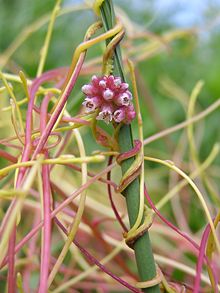How is Cuscuta adapted to become a parasitic plant?
After a dodder attaches itself to a plant, it wraps itself around it. If the host contains food beneficial to dodder, the dodder produces haustoria that insert themselves into the vascular system of the host. The original root of the dodder in the soil then dies. The dodder can grow and attach itself to multiple plants. In tropical areas it can grow more or less continuously, and may reach high into the canopy of shrubs and trees; in temperate regions it is an annual plant and is restricted to relatively low vegetation that can be reached by new seedlings each spring.
Dodder is parasitic on a very wide variety of plants, including a number of agricultural and horticultural crop species, such as alfalfa, lespedeza, flax, clover, potatoes,chrysanthemum, dahlia, helenium, trumpet vine, ivy and petunias, among others.
Dodder ranges in severity based on its species and the species of the host, the time of attack, and whether any viruses are also present in the host plant. By debilitating the host plant, dodder decreases the ability of plants to resist virus diseases, and dodder can also spread plant diseases from one host to another if it is attached to more than one plant.



 Cuscuta on acacia tree in
Cuscuta on acacia tree in